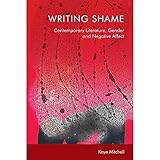Writing Shame : Gender, Contemporary Literature and Negative Affect / Kaye Mitchell.
Material type: TextPublisher: Edinburgh : Edinburgh University Press, [2022]Copyright date: ©2020Description: 1 online resource (296 p.)Content type:
TextPublisher: Edinburgh : Edinburgh University Press, [2022]Copyright date: ©2020Description: 1 online resource (296 p.)Content type: - 9781474461849
- 9781474461863
- 809.93353 23
- PN56.S538 .M583 2020
- online - DeGruyter
| Item type | Current library | Call number | URL | Status | Notes | Barcode | |
|---|---|---|---|---|---|---|---|
 eBook
eBook
|
Biblioteca "Angelicum" Pont. Univ. S.Tommaso d'Aquino Nuvola online | online - DeGruyter (Browse shelf(Opens below)) | Online access | Not for loan (Accesso limitato) | Accesso per gli utenti autorizzati / Access for authorized users | (dgr)9781474461863 |
Browsing Biblioteca "Angelicum" Pont. Univ. S.Tommaso d'Aquino shelves, Shelving location: Nuvola online Close shelf browser (Hides shelf browser)

|

|

|

|

|

|

|
||
| online - DeGruyter Sound Change / | online - DeGruyter Asian Cinema : A Regional View / | online - DeGruyter Fashion on the Red Carpet : A History of the Oscars®, Fashion and Globalisation / | online - DeGruyter Writing Shame : Gender, Contemporary Literature and Negative Affect / | online - DeGruyter The Edinburgh History of Reading : Common Readers / | online - DeGruyter The Edinburgh History of Reading : Subversive Readers / | online - DeGruyter ReFocus : The Films of Paul Schrader / |
Frontmatter -- Contents -- Acknowledgements -- Introduction: Beginning with Stigma -- Chapter 1. Forgetting and Remembering Lesbian Pulp: Shame, Recuperation and Queer History -- Chapter 2. Cleaving to the Scene of Shame: Stigmatised Childhoods in The End of Alice and Two Girls, Fat and Thin -- Chapter 3. ‘The Dumb Cunt’s Tale’: Desire, Shame and Self-Narration in Contemporary Autofiction -- Chapter 4. The Shame of Being a Man: Humiliation and/as Heroism -- Conclusion: The Shame is (Not) Over -- Bibliography -- Index
restricted access online access with authorization star
http://purl.org/coar/access_right/c_16ec
Examines the intersection of shame, gender and writing in contemporary literatureConsiders the particular intersection of shame, gender and writing in literature produced since the 1990sViews shame as a constitutive factor in the social construction and experience of femininityAnalyses a diverse range of texts from pulp to literary fiction to life writing and autofiction, with a self-reflexive focus on the formal disjunctions produced by/in the writing of shame, and on the shame attending the act of writing itselfOffers political readings of neglected genres (lesbian pulp fiction), highly topical texts (like Kraus’s I Love Dick and Knausgaard’s My Struggle), and established authors (such as Mary Gaitskill and A.M. Homes)Through readings of an array of recent texts – literary and popular, fictional and autofictional, realist and experimental – this book maps out a contemporary, Western, shame culture. It unpicks the complex triangulation of shame, gender and writing, and intervenes forcefully in feminist and queer debates of the last three decades. Starting from the premise that shame cannot be overcome or abandoned, and that femininity and shame are utterly and necessarily imbricated, Writing Shame examines writing that explores and inhabits this state of shame, considering the dissonant effects of such explorations on and beyond the page.
Mode of access: Internet via World Wide Web.
In English.
Description based on online resource; title from PDF title page (publisher's Web site, viewed 27. Jan 2023)


